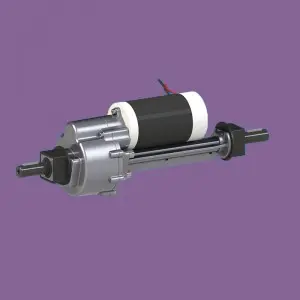For a riding lawn mower, one of the most critical components for smooth operation is the transaxle. This article will take an in-depth look at what a transaxle is, its function, and most importantly, its location on a riding lawn mower.
What is a transaxle?
A transaxle is a mechanical component that combines the functions of the transmission and axle into a single unit. Simply put, it is responsible for transferring power from the engine to the wheels, allowing the lawnmower to move forward or backward. The transaxle plays a vital role in controlling the speed and torque of your lawn mower, making it an important part of the overall functionality of the machine.
Transaxle components
The transaxle consists of several key components:
- DRIVE GEARS: These gears help change the speed of the lawn mower. Depending on the model, the transaxle may have multiple gears to accommodate different speeds.
- Differential: This component allows the wheels to turn at different speeds, which is especially important when cornering. Without a differential, the wheels would be forced to spin at the same speed, causing slippage and difficult maneuvering.
- AXLE: The axle is the shaft that connects the wheels to the transaxle. They transmit the power generated by the engine to the wheels, thereby enabling movement.
- Hydraulic System: In some riding lawn mowers, the transaxle may include a hydraulic system that helps control the speed and direction of the mower.
The Importance of Transaxle
The transaxle is critical for several reasons:
- Power Transmission: It efficiently transfers power from the engine to the wheels, ensuring smooth operation of the lawn mower.
- SPEED CONTROL: The transaxle allows the operator to control the speed of the mower, making it easier to navigate different terrains.
- MOBILITY: By including a differential, a transaxle enhances the mower’s maneuverability, making it easier to turn and maneuver around obstacles.
- Durability: A well-maintained transaxle can significantly extend the life of your riding lawn mower, reducing the need for costly repairs or replacements.
Where is the transaxle located on a ride-on lawn mower?
Now that we understand what a transaxle is and its importance, let’s discuss its location on a riding lawn mower.
General location
The transaxle is usually located on the rear of a riding lawn mower. This positioning allows for a more balanced weight distribution, which is crucial for stability during operation. The transaxle is usually mounted directly to the lawn mower’s frame and connected to the rear wheels via an axle.
Identify transaxle
If you are looking for a transaxle on your riding lawn mower, the following steps can help you:
- SAFETY FIRST: Before attempting to locate or inspect the transaxle, make sure the mower is turned off and the key is removed from the ignition. It is also recommended to disconnect the battery to prevent accidental starting.
- Lift the Lawn Mower: If your lawn mower has a deck that can be removed or raised, doing so will provide better access to the rear of the machine. This will give a clearer view of the transaxle.
- Look for the Rear Housing: The transaxle is usually mounted inside a metal housing at the rear of the lawnmower. Its shape may be rectangular or square, depending on the model.
- CHECK AXLE: The transaxle has two axles extending from it, leading to the rear wheels. These axles are a clear indication that you have found the transaxle.
- CHECK MANUAL: If you still can’t find the transaxle, refer to the owner’s manual for your specific riding lawn mower model. The manual usually contains diagrams and detailed descriptions of various components, including the transaxle.
Transaxle Frequently Asked Questions
Like any mechanical component, transaxles can develop problems over time. Here are some common issues to be aware of:
- Fluid Leak: If you notice fluid pooling underneath your lawnmower, it may indicate a transaxle leak. If left unaddressed, this can lead to insufficient lubrication and eventual failure.
- Strange Noises: Unusual sounds, such as grinding or clunking, may indicate a problem within the transaxle. These noises may indicate worn gears or other internal issues.
- Difficulty in Movement: If the lawn mower has difficulty moving forward or backward, it may be a sign of transaxle failure. This may need to be inspected and possibly replaced.
- OVERHEAT: If the transaxle becomes overheated during operation, it may indicate a lack of lubrication or other internal issues.
Maintenance tips for transaxle
To ensure the longevity and proper operation of the transaxle, regular maintenance is essential. Here are some tips:
- CHECK FLUID LEVEL: Check the fluid level in the transaxle regularly. Low fluid levels can cause overheating and damage.
- CHECK FOR LEAKS: Watch for any signs of fluid leakage. Addressing leaks promptly can prevent more serious problems from occurring.
- Clean the Area: Dirt and debris can accumulate around the transaxle, causing overheating. Clean the area regularly to ensure proper airflow and cooling.
- FOLLOW MANUFACTURER GUIDELINES: Be sure to refer to your owner’s manual for specific maintenance recommendations for your riding lawn mower transaxle.
- SEEK PROFESSIONAL HELP: If you encounter any problem that you cannot solve, it is best to consult a professional mechanic who specializes in ride-on lawn mowers.
in conclusion
The transaxle is an important part of a riding lawn mower, playing a vital role in power transmission, speed control, and maneuverability. Understanding its location and functions can help you maintain your lawn mower effectively and resolve any issues that may arise. By paying close attention to your transaxle and performing regular maintenance, you can ensure that your riding lawn mower runs smoothly for years to come. Whether you’re mowing your lawn or tackling a large landscaping project, a well-functioning transaxle will make your mowing experience more enjoyable.
Post time: Oct-30-2024


